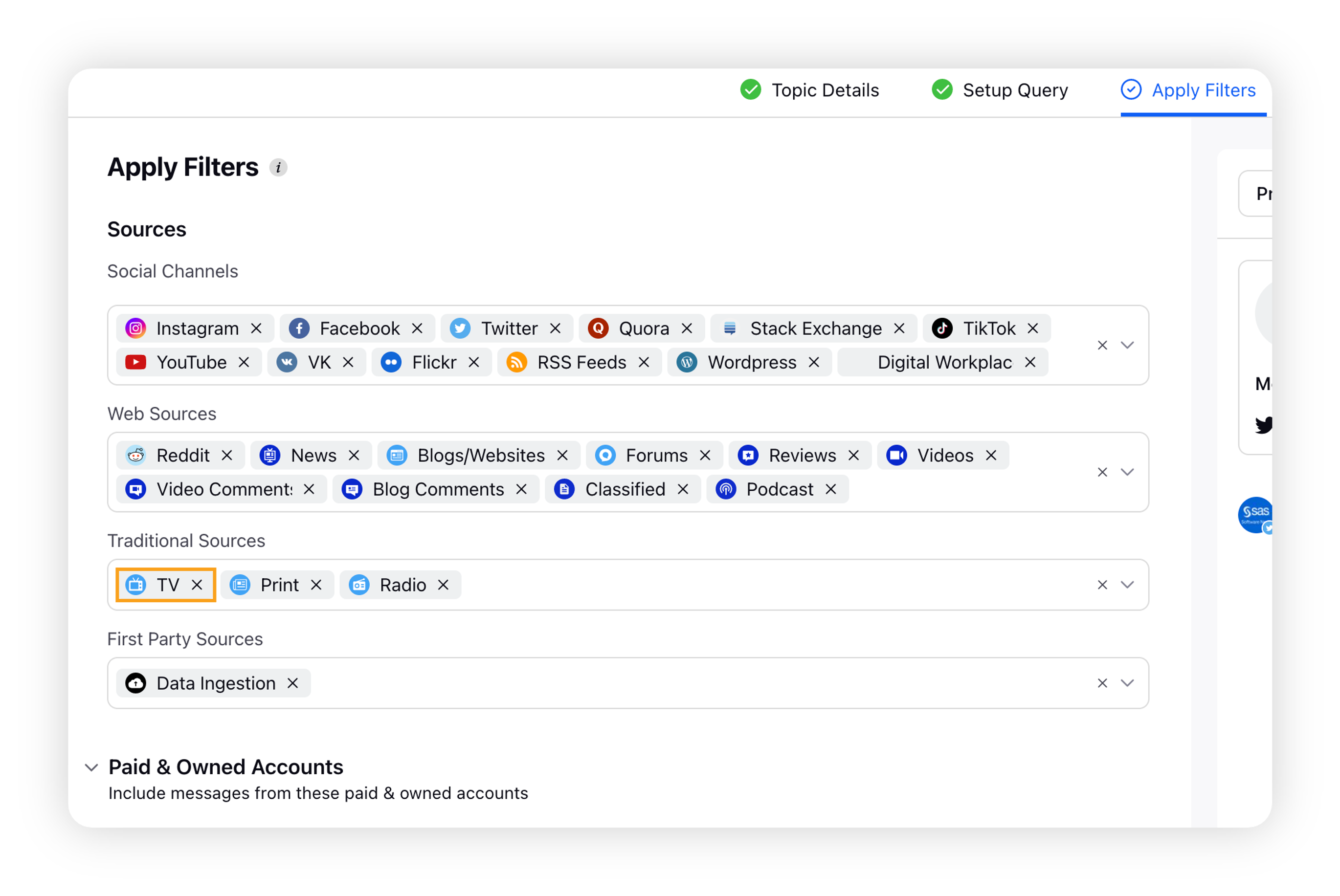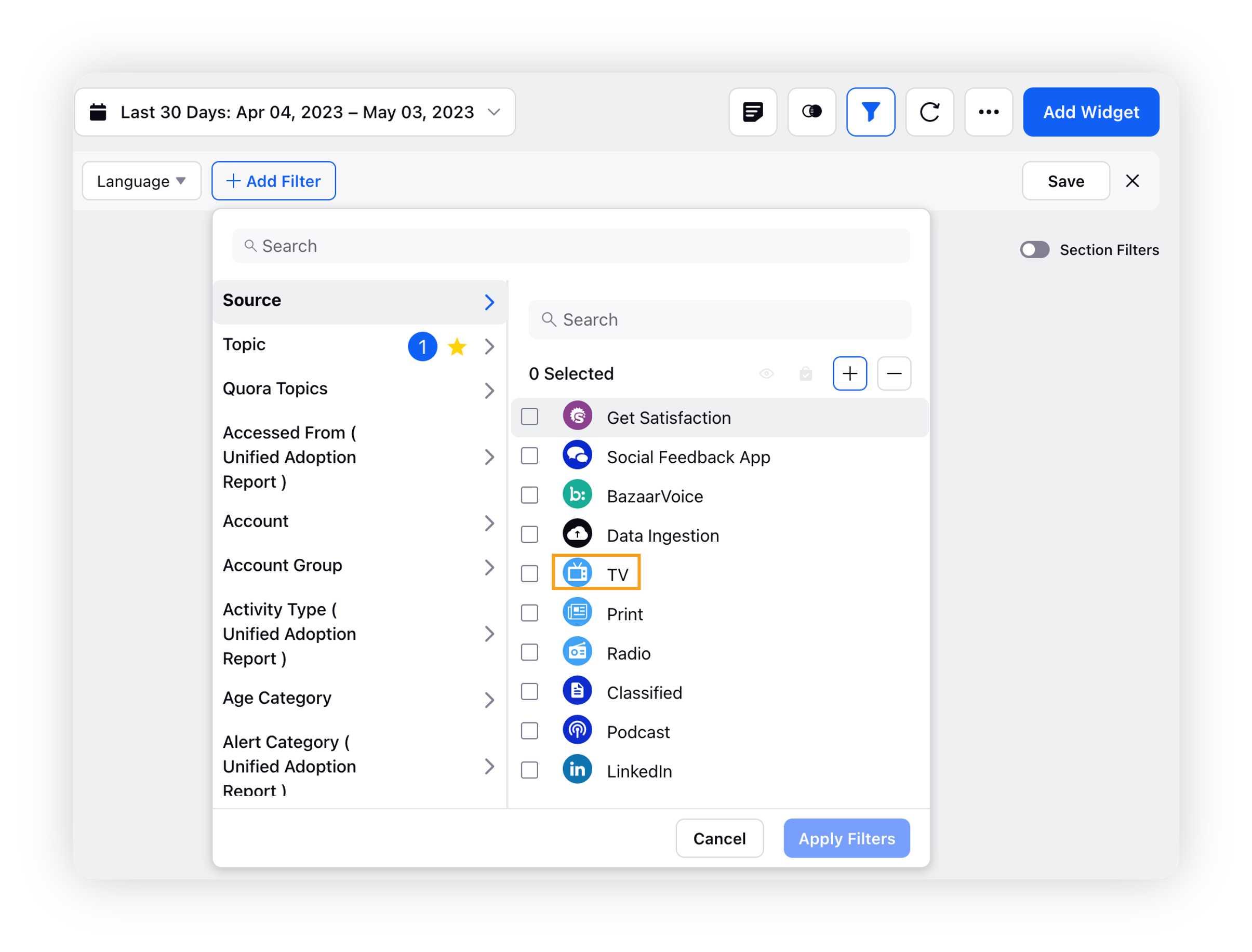TV as a Listening source
Updated
By adding TV as a Listening Source, you can listen to and learn from them.
Sprinklr supports TV as one of its traditional Listening Sources. LexisNexis provides us with a transcript of major tv sources and Video Clips for popular news channels and radio stations. Video clips are only available for the first 30/60 days, depending on the outlet, after the original air date. Beyond 30/60 days, only text transcripts are available.
1,000+ Local US TV stations including ABC, CBS, Fox, and NBC affiliates in all Nielsen DMAs
80+ US cable channels including major cable news (Bloomberg, CNBC, CNN, Fox News, Fox Business, MSNBC)
110+ TV channels in Canada including CBC, CTV, City, and Global affiliate stations
60+ TV channels in the UK including BBC, ITV, and Sky content
120+ US Spanish language stations
Al Jazeera in Arabic and English
Archive up to 2 years
Nielsen Audience and Publicity Values
Capability: Transcripts for TV are available as a part of metadata.
TV source capabilities
Source: TV
Source of data: Datavendor [LexisNexis]
Coverage: Sprinklr includes Broadcast (TV & Radio) with over 2100 channels in all 210 US Nielsen markets, Canada, and the UK.
Latency: Less than 60 Mins
Historical data: Q3 2017
Backfill support: Yes
Archive support: Up to 2 Years
Author/ Profile metadata details: Yes (earned)
Author name available
Note: Author URL is not available for TV & Radio Sources, hence distinct users cannot be determined accurately.
AI-enriched data: Sentiment, Emotions, Language, Word cloud, Topic Cluster, Age (profile), Gender (profile), Smart Themes Clustering, Smart Insights
Message type: TV News
Media type: TV and Video
TV data entities in Social Listening
TV specific Data Entities
Data Entities | Type | Description |
EMV | Metric | EMV stands for Earned Media Value. EMV is dependent on four factors namely:
If any of the above is not available for a particular domain, the value is estimated as zero. |
Media Source Category | Dimension | Describes the type of publication an article is from (for sources News, Print, TV, Radio) |
Media Source Name | Dimension | Name of the Media Source and applicable for News, Blogs, Print and TV Sources. |
Media Title | Dimension | Title of the message like Web News/Blog, Print or TV |
Media Reach | Metric | Media Reach is the measure of the size of the potential audience of a message for Web (News, Blogs, Forums, Reviews) and Traditional (TV, Print, Radio) sources. It is calculated through circulation numbers for print, viewership for Broadcast (from Nielsen), and Unique Visitors per Month (UVPM) for Online News & Web domains. These numbers are updated quarterly and are provided by one of our data vendors. Note: Some web domains may not have media reach populated in them." |
Editorial Rank | Dimension | Ranking of the media source based on its presence such as International, National, etc. The scale of ranking is from 1 to 5. Refer to this KP article for more information. |
TV Supported Location Stats
Data Entities | Type | Description |
Country | Metric | The user-provided or Sprinklr-identified country of origin of the message. |
State | Metric | The user-provided or Sprinklr-identified state of origin of the message. |
To fetch data from TV
In order to fetch data from TV, you need to create a Topic with TV as its source.
While creating or editing your Topic, click the Apply Filters tab, and select TV in the Traditional Sources.

You can also select Source: TV from the dashboard/widget filter.

To learn in detail about how to create a topic, read Create a Topic in Topic Creation UI.
Limitations
TV as a source does not fall under the Source verification process as this is controlled by the data vendor. The coverage list is a part of a package that is defined by the data vendor, and is updated once a year.
To backfill data from TV
Once the Topic is created/ updated, you can backfill the topic going far back to Quarter 3 of 2017.
To know more about how to backfill data, check out Listening Backfill for Topics.